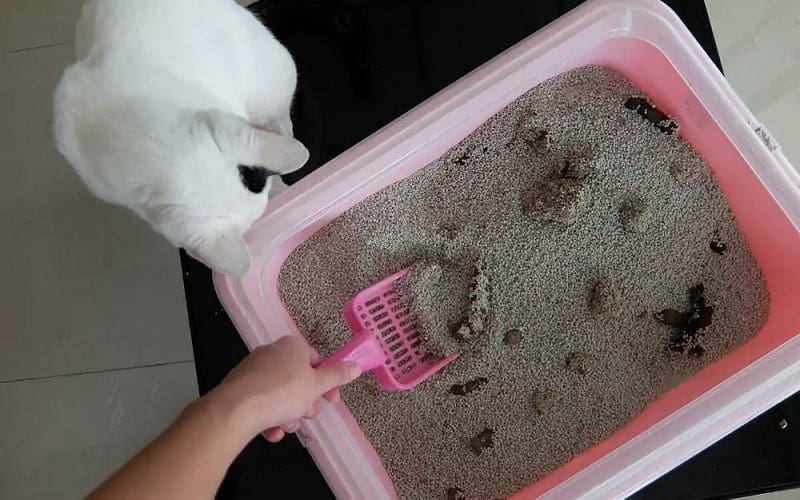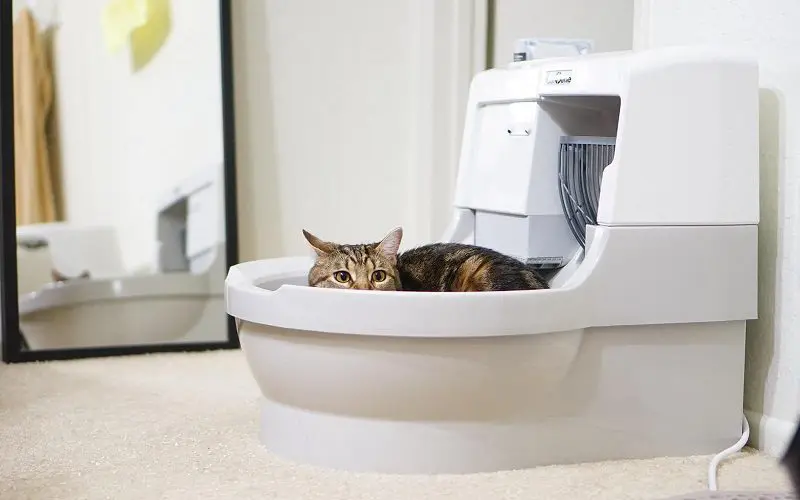Last Updated: 1 year ago
While it may not be the most pleasant topic of conversation, understanding your cat’s pooping habits is essential to their health and wellbeing.
Knowing how often cats should be pooping can help you identify any potential issues early on and ensure that your cat is getting the care they need.
So let’s dive in and learn more about how often do cats poop!
How Often Do Cats and Kittens Poop?

A healthy digestive system in cats is vital for their overall health and well-being.
While different cats may have different ‘normal’ frequencies of bowel movements, generally speaking, most healthy cats will defecate anywhere from one to four times per day.
Kittens may poop up to three times per day, while older cats usually do so less often.
As cats grow older, they poop less frequently. Most cats poop about once a day, though it’s also normal for a cat to poop every 12–36 hours.
Normal or healthy cat poop is deep brown in color, formed and moist, neither very hard nor soft, has an odor but is not foul, and has no mucous or blood.
Things You Should Know About Cat Poop

If you’re a cat owner, then you know that dealing with your feline’s poop is just part of the territory. But what do you do when your cat’s poop doesn’t look quite right?
When it comes to your cat’s poop, there are a few things you can look for that might indicate something is wrong.
For example, runny or stringy poop can be a sign of cat diarrhea, while black or tarry poop can be a sign of constipation.
If you think your cat may be constipated, the best thing to do is to take them to the vet. They will be able to check for an obstruction or impaction and help treat your cat.
So, if you’re noticing anything abnormal about your cat’s poop, it’s always best to err on the side of caution and take them to the vet to get checked out.
What Does Normal or Healthy Cat Poop Look Like?
Normal cat poop should be well-formed, moist, and easy to pass.
It typically has a brown color and maintains its shape without being too hard or too soft, and it is not too smelly.
It should also have a sausage-like shape and not contain any foreign objects or parasites.
What Does Unhealthy or Abnormal Cat Poop Look Like?
Abnormal cat poop may vary in appearance and could indicate underlying health issues.
Signs of unhealthy poop include diarrhea (loose, watery stool), constipation (dry, hard stool), blood or mucus in the stool, or changes in color and odor.
It can have different colors, such as black, red, light-brown, yellow, or green, which may indicate bleeding, liver problems, gallbladder issues, or infections.
It can also be too hard or too soft, which may indicate constipation or diarrhea. It can also have a very foul odor or contain blood, mucus, hair, bones, or worms.
How Long Can a Cat Go Without Pooping?
Cats should ideally poop at least once a day. However, healthy cats can go up to 48 hours without pooping.
A cat should not go longer than 48 hours without pooping, unless they just had surgery or are recovering from diarrhea.
If a cat hasn’t pooped for more than two days, it’s essential to consult a veterinarian to rule out any medical issues.
What If Your Cat Poops More Than Twice a Day?
While it’s not uncommon for cats to poop multiple times a day, frequent or excessive pooping could indicate overfeeding, dietary changes, or gastrointestinal issues.
Pooping more than twice a day is not necessarily a problem for cats, as long as the poop is normal in appearance and consistency.
However, if your cat has diarrhea, which means the poop is watery, loose, or unformed, then they may have an underlying health issue that needs to be addressed.
Some common causes of diarrhea in cats are dietary changes, food allergies, infections, parasites, inflammatory bowel disease, or stress.
Monitoring your cat’s poop consistency and frequency is crucial to identify any potential health concerns.
What Factors Affect How Often Cats Poop?
Several factors can influence a cat’s pooping frequency, including diet, hydration levels, age, activity level, underlying health conditions, stress, and litter box habits.
For example, cats that eat more fiber, drink more water, exercise more, or are younger may poop more often than cats that eat less fiber, drink less water, exercise less, or are older.
Cats that have health problems, such as kidney disease, hyperthyroidism, or diabetes, may also poop more or less often than normal.
Cats that have litter box issues, such as aversion, anxiety, or preference, may also poop less often or outside the litter boxh.
A balanced diet with adequate hydration, regular exercise, and a stress-free environment contribute to healthy digestion and regular bowel movements in cats.
Signs of Constipation in Cats

If you think your cat may be constipated, there are a few things you can look for in their pooping habits, behavior, or appearance.
- Straining to Poop: If your cat is going to the bathroom more frequently than usual but only producing a small amount of stool, or if they seem to be straining to poop, this may be a sign of constipation.
- Lack of Appetite: If your cat is not interested in eating or drinking, this may be a sign that they are not feeling well.
- Vomiting: If your cat is vomiting, this may be a sign of an obstruction or impaction.
- Lethargy: If your cat is more tired than usual and doesn’t want to move around much, this may be a sign of constipation.
- Abdominal Pain: If your cat is showing signs of abdominal pain, such as crying when touched or hunching over posture, this may be a sign of constipation.
If your cat is constipated, there are a few things you can do to help relieve its discomfort. Start by adding more fiber to their diet with canned pumpkin or high-fiber kibble.
Make sure they’re drinking plenty of water throughout the day, and if their constipation persists, it may be time for a vet visit.
Final Word
As the kitten grows older, their bowel movements will become more regular and less frequent.
Knowing how often cats poop can help you identify any potential problems early on and take the necessary steps to ensure that your cat has a healthy bowel movement schedule.
If you notice any changes in their pooping habits or if they seem to be having difficulty with their bowel movements, contact your veterinarian right away for advice.
With proper care and attention, you can help keep your cat happy and healthy!
